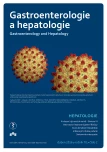Infections in liver cirrhosis – our experience
Authors:
L. Mihaličová 1; Z. Bališová 1; M. Janičko 2; S. Dražilová 1
Authors‘ workplace:
Oddelenie vnútorného lekárstva s JIS metabolickou, Nemocnica Poprad, a. s., Slovenská republika
1; I. interná klinika LF UPJŠ a UN L. Pasteura Košice, Slovenská republika
2
Published in:
Gastroent Hepatol 2016; 70(2): 133-137
Category:
Hepatology: Original Article
doi:
https://doi.org/10.14735/amgh2016133
Overview
Infection in cirrhotic patients is a common complication that has an impact on clinical course and prognosis. In our retrospective analysis, we evaluated 72 patients with liver cirrhosis who were hospitalized at the Department of Internal Medicine, Hospital Poprad. During hospitalization, we actively searched for infectious complications. Infectious complications were found in 37 patients (51.38%). Patients with alcoholic liver cirrhosis had a statistically significant higher incidence of infection than patients with other types of cirrhosis (p = 0.031). Fourteen patients had urinary tract infection, 11 had respiratory infection, 8 had spontaneous bacterial peritonitis, one had skin and soft tissue infection, and one had Clostridium difficile infection. Two patients had both urinary track infection and bronchopneumonia. There was no significant difference in age, gender, duration of hospitalization, or mortality between patients with infection and those without infection. Infectious complications are common in liver cirrhotic patients, especially if cirrhosis is caused by alcoholic liver disease.
Key words:
liver cirrhosis – alcoholic liver disease – infections – urinary tract infection – bronchopneumonia – spontanoues bacterial peritonitis
The authors declare they have no potential conflicts of interest concerning drugs, products, or services used in the study.
The Editorial Board declares that the manuscript met the ICMJE „uniform requirements“ for biomedical papers.
Submitted:
23. 2. 2016
Accepted:
22. 3. 2016
Sources
1. Bruns T, Zimmermann HW, Stallmach A. Risk factors and outcome of bacterial infections in cirrhosis. World J Gastroenterol 2014; 20(10): 2542–2554. doi: 10.3748/wjg.v20.i10.2542.
2. Pleguezuelo M, Benitez JM, Jurado J et al. Diagnosis and management of bacterial infections in decompensated cirrhosis. World J Hepatol 2013; 5(1): 16–25. doi: 10.4254/wjh.v5.i1.16.
3. Fernández J, Acevedi Hm Castro M et al. Prevalence and risk factors of infections by multiresistant bacteria in cirrhosis: a prospective study. Hepatology 2012; 55(5): 1551–1561. doi: 10.1002/hep.25532.
4. Bunchorntavakul C, Chavalitdhamrong D. Bacterial infections other than spontaneous bacterial peritonitis in cirrhosis. World J Hepatol 2012, 4(5): 158–168. doi: 10.4254/wjh.v4.i5.158.
5. Acevedo J. Multiresistant bacterial infections in liver cirrhosis: clinical impact and new empirical antibiotic treatment policies. World J Hepatol 2015; 7(7): 916–921. doi: 10.4254/wjh.v7.i7.916.
6. Preda CM, Ghita R, Ghita C et al. A retrospective study of bacterial infections in cirrhosis. Maedica (Buchar) 2011; 6(3): 185– 192.
7. Dražilová S, Janičko M. Infekcie pri cirhóze. Gastroenterol Prax 2015; 14(1): 31– 34.
8. Arvaniti V, D’Amico G, Fede G et al. Infections in patients with cirrhosis increase mortality four-fold and should be used in determining prognosis. Gastroenterology 2010; 139(4): 1246–1256. doi: 10.1053/j.gastro.2010.06.019.
9. Fernández Guerrero ML, González López J, Górgolas M. Infectious endocarditis in patients with cirrhosis of the liver: a model of infection in the frail patient. Eur J Clin Microbiol Infect Dis 2010; 29(10): 1271–1275. doi: 10.1007/s10096-010-0998-8.
10. Bajaj JS, Zadvornova Y, Heuman DM et al. Association of proton pump inhibitor therapy with spontaneous bacterial peritonitis in cirrhotic patients with ascites. Am J Gastroenterol 2009; 104(5): 1130–1134. doi: 10.1038/ajg.2009.80.
11. Deshpande A, Pasupuleti V, Thota Pet al. Acid-suppressive therapy is associated with spontaneous bacterial peritonitis in cirrhotic patients: a meta-analysis. J Gastroenterol Hepatol 2013; 28(2): 235–242. doi: 10.1111/jgh.12065.
12. Jalan R, Fernandez J, Wiest R. Bacterial infections in cirrhosis: a position statement based on the EASL Special Conference 2013. J Hepatol 2014; 60(6): 1310–1324. doi: 10.1016/j.jhep.2014.01.024.
13. Prado V, Acevedo J, Fernández J. Bacterial infections in cirrhosis: prevention and treatment. Curr Hepatology Rep 2014; 13: 43–49.
14. European Association for the Study of the Liver. EASL clinical practice guidelines on the management of ascites, spontaneous bacterial peritonitis, and hepatorenal syndrome in cirrhosis. J Hepatol 2010; 53(3): 397–417. doi: 10.1016/j.jhep.2010.05.004.
15. Hou MC, Lin HC, Liu TT et al. Antibiotic prophylaxis after endoscopic therapy prevents rebleeding in acute variceal hemorrhage: a randomized trial. Hepatology 2004; 39(3): 746–753.
16. De Franchis R, Baveno V. Revising consensus in portal hypertension: report of the Baveno V consensus workshop on methodology of diagnosis and therapy in portal hypertension. J Hepatol 2010; 53(4): 762–768. doi: 10.1016/j.jhep.2010.06.004.
Labels
Paediatric gastroenterology Gastroenterology and hepatology SurgeryArticle was published in
Gastroenterology and Hepatology

2016 Issue 2
Most read in this issue
- Eziclen® – reliable method for cleaning the bowel before the colonoscopic examination
- Chronically elevated levels of liver enzymes
- Methods for non-invasive determination of advancement of liver fibrosis
- Severe life-threatening parasitic liver disease complicated by dissemination to the lungs
